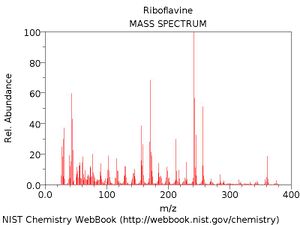It07:Riboflavin
| Riboflavin | |||
|---|---|---|---|
 | |||
| IUPAC Systematic name | |||
| 7,8-dimethyl-10-(D-ribo-2,3,4,5-tetrahydroxypentyl)
benzo[g]pteridine-2,4(3H,10H)-dione | |||
| Other name | |||
| Vitamin B2, Lactoflavin, 7,8-Dimethyl-10-ribitylisoalloxazine | |||
| Indentifiers | |||
| CAS number | 83-88-5 | ||
| SMILES | O=C(N3)C2=NC1=CC(C)=C(C)
C=C1N(CC(O)C(O)C(O)CO)C2=NC3=O] | ||
| Chemical Data | |||
| Molecular formula | C17H20N4O6 | ||
| Molar mass | 376.4 g/mol | ||
Riboflavin is a water-soluble B-vitamin found in all living cells of the body, it takes its same from the Latin flavus meaning ‘yellow’. It is essential for production of energy as it aids the metabolism of lipids, carbohydrates and amino acids.
Role Within the Body
Within the body, riboflavin can be converted to the cofactors Flavin Adenine Dinucleotide (FAD) or Flavin Mononucleotide (FMN), which are crucial in aerobic respiration. Proteins bind to the FAD and FMN producing what are known as flavoproteins, these are present in great number throughout the body, especially in areas where energy is needed in large quantities, for example the skeletal muscles and heart.
When converted to FAD, riboflavin also acts as a cofactor for the enzyme Methylenetetrahydrofolate reductase (MTHFR), which is essential in the breakdown of the amino-acid homologue Homocysteine. Some humans have a mutated MTHFR enzyme which does not function correctly, thus leading to a build up of homocysteine in the body, this has been found to be associated with an increased risk of disease to the cardiovascular system. It has also been found that an increase in the level of riboflavin in the diet can reduce the body’s homocysteine levels, thus helping to protect against cardiovascular disease. Riboflavin also acts as a cofactor for the enzyme glutathione reductase, the enzyme responsible for “recycling” the tripeptide glutathione by converting it back to its reduced version. Glutathione is an antioxidant which donates an electron to reactive free radical species, thus preventing them from reacting with the body’s tissues, potentially causing damage. FAD is also a cofactor to the enzyme kynurenine mono-oxygenase in the conversion of the amino acid tryptophan to niacin (Vitamin B3).
Sources of Riboflavin
The most common foods which are a good source of riboflavin include milk, cheese, and fish. Offal such as liver and kidneys are also contain high levels, however the highest natural occurence of vitamin B2 is in Brewer's Yeast[1]


